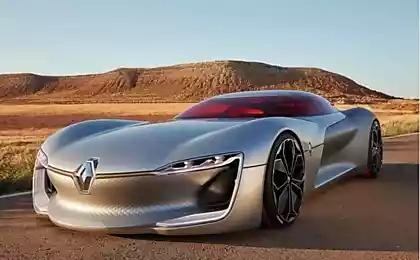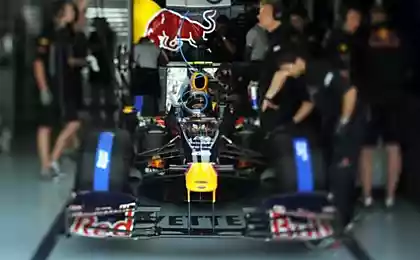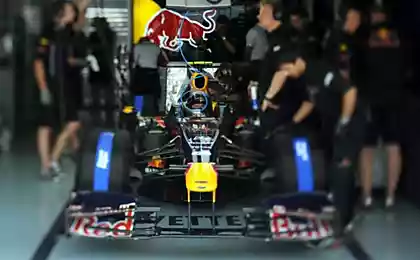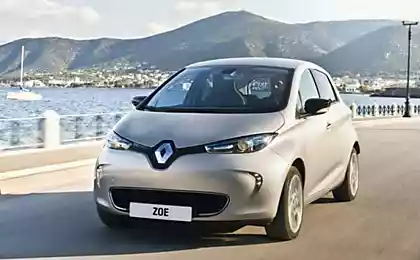563
Renault Ft-17
Another compilation for fans of military hardware.
Renault FT-17 (Automitrailleuse à chenilles Renault FT modèle 1917) (fr. Renault FT-17) - the first light tank. The first tank, which had a circular tower of rotation (360 degrees), and the first tank of classical configuration (separation of management - in front, fighting - in the center and engine - rear). One of the best tanks of the First World War.
1.

It developed in the years 1916-1917 under the direction of Louis Renault as a tank close infantry support. Adopted by the French army in 1917. Released about 3500 copies. Moreover, Reno FT-17 produced under the license in the United States (called M1917 (Ford Two Man), issued 950 copies), and in Italy (under the name FIAT 3000). It operated until the 1940s.
2.

FT-17 tank was the first who had the layout which has received later the name "classic". Branch management is located in the front part of the tank fighting compartment with a tower circular rotation, which was the main armament of the tank, located behind it, in the middle of the tank and the engine-transmission compartment occupied the rear of the hull. The crew consisted of two people - the driver and commander, is also engaged in servicing gun or machine gun.
3.

FT-17, in addition to the naked version of the tank management, comes in two versions, "cannon" and "machine-gun", the installation of the differing arms in the tower. Most of the tanks, about 2,100 cars, was released in the machine-gun version, cannon were fired at about 1500 cars.
4.
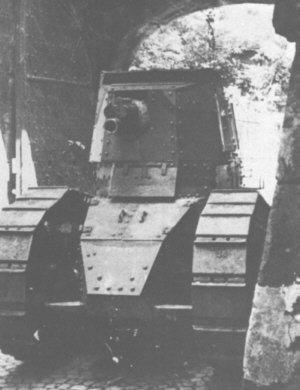
Armament "cannon" option consisted of a semi-automatic 37-mm rifled gun "Gochkiss» SA18, created on the basis of an infantry gun mod.1916 TR. The gun had a barrel length of 21 mm caliber or 777, the vertical wedges and spring recoil device. It places the gun to install in front of the tower, in the hemispherical armored mask, horizontal trunnion mounted in a turning point in the vertical axis basically an armored shield. Pointing guns carried her free swing using shoulder rest, maximum vertical aiming angle from -20 to +35 degrees.
5.

Renault FT 17 was in service until the beginning of World War II in the armies of France and Poland. It operated in North Africa. Captured French tanks were used by the Wehrmacht as training machines, as well as logistic patrol and protect airfields. In 1919, the Polish Army of General Haller in France formed one regiment of tanks equipped with 120 tanks FT-17 (fourth place in the world with respect to existing armored forces). In June 1919 the regiment of tanks with the army gen. Haller returned to Poland, with all the equipment; He participated in the Polish-Soviet war. By the beginning of World War II, the Polish army had 102 tanks of this type. In 1919, six tanks were captured by the Red Army near Odessa at allied expeditionary force; one tank sent to Moscow, Lenin. He gave the corresponding order - and the factory Red Sormovo tanks carefully copied and released with the engine AMO and armor Izhora factory under the name "Freedom Fighter Comrade Lenin", sometimes referred to as the first Soviet tank "M". However, in the way some of the details and units have been lost, so, for example, the gearbox had to re-design.
The task failed, but only in part: it was built only 15 copies, and, at the conclusion of one of the commissions, they were "not satisfactory in quality, inconvenient to own a weapon, partly totally unarmed».
6.

Interesting facts
* The first tank unit on the territory of the former Russian Empire - Panzer Division under the Sovnarkom Soviet Ukraine - was founded in Kharkov kraskomom Selyavkinym in 1919 from captured tanks Renault FT-17, captured near Odessa. Subsequently, the first Soviet tank unit was reorganized in the tank squadron of the Red Army (the so-called "Lefortovo") (1922), the main strike force of which were captured British tanks Mark V.
* Brest Fortress: September 14, 1939 77 10 German tanks Panzer tried to take the city and the fortress to raid, but were repulsed by the Polish infantry supported by 12 tanks FT-17.
7.

8.

9.

10.

11.
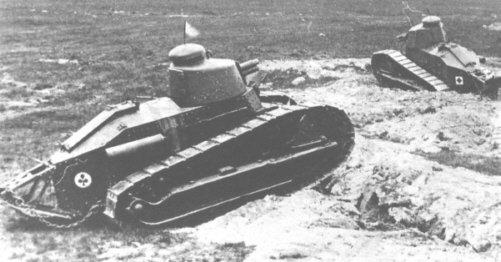
12.

13.

14.
during the Spanish Civil War.
Republicans used the same tanks Schneider CA-1
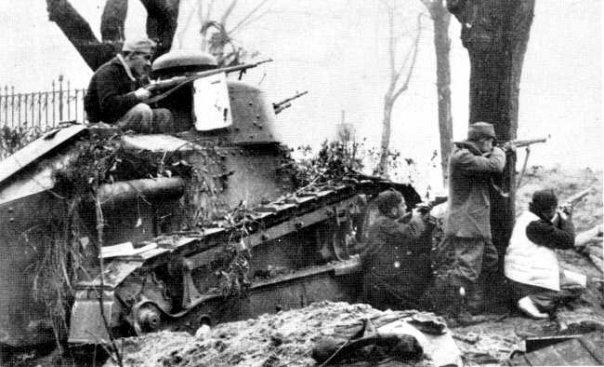
Source:
Renault FT-17 (Automitrailleuse à chenilles Renault FT modèle 1917) (fr. Renault FT-17) - the first light tank. The first tank, which had a circular tower of rotation (360 degrees), and the first tank of classical configuration (separation of management - in front, fighting - in the center and engine - rear). One of the best tanks of the First World War.
1.

It developed in the years 1916-1917 under the direction of Louis Renault as a tank close infantry support. Adopted by the French army in 1917. Released about 3500 copies. Moreover, Reno FT-17 produced under the license in the United States (called M1917 (Ford Two Man), issued 950 copies), and in Italy (under the name FIAT 3000). It operated until the 1940s.
2.

FT-17 tank was the first who had the layout which has received later the name "classic". Branch management is located in the front part of the tank fighting compartment with a tower circular rotation, which was the main armament of the tank, located behind it, in the middle of the tank and the engine-transmission compartment occupied the rear of the hull. The crew consisted of two people - the driver and commander, is also engaged in servicing gun or machine gun.
3.

FT-17, in addition to the naked version of the tank management, comes in two versions, "cannon" and "machine-gun", the installation of the differing arms in the tower. Most of the tanks, about 2,100 cars, was released in the machine-gun version, cannon were fired at about 1500 cars.
4.

Armament "cannon" option consisted of a semi-automatic 37-mm rifled gun "Gochkiss» SA18, created on the basis of an infantry gun mod.1916 TR. The gun had a barrel length of 21 mm caliber or 777, the vertical wedges and spring recoil device. It places the gun to install in front of the tower, in the hemispherical armored mask, horizontal trunnion mounted in a turning point in the vertical axis basically an armored shield. Pointing guns carried her free swing using shoulder rest, maximum vertical aiming angle from -20 to +35 degrees.
5.

Renault FT 17 was in service until the beginning of World War II in the armies of France and Poland. It operated in North Africa. Captured French tanks were used by the Wehrmacht as training machines, as well as logistic patrol and protect airfields. In 1919, the Polish Army of General Haller in France formed one regiment of tanks equipped with 120 tanks FT-17 (fourth place in the world with respect to existing armored forces). In June 1919 the regiment of tanks with the army gen. Haller returned to Poland, with all the equipment; He participated in the Polish-Soviet war. By the beginning of World War II, the Polish army had 102 tanks of this type. In 1919, six tanks were captured by the Red Army near Odessa at allied expeditionary force; one tank sent to Moscow, Lenin. He gave the corresponding order - and the factory Red Sormovo tanks carefully copied and released with the engine AMO and armor Izhora factory under the name "Freedom Fighter Comrade Lenin", sometimes referred to as the first Soviet tank "M". However, in the way some of the details and units have been lost, so, for example, the gearbox had to re-design.
The task failed, but only in part: it was built only 15 copies, and, at the conclusion of one of the commissions, they were "not satisfactory in quality, inconvenient to own a weapon, partly totally unarmed».
6.

Interesting facts
* The first tank unit on the territory of the former Russian Empire - Panzer Division under the Sovnarkom Soviet Ukraine - was founded in Kharkov kraskomom Selyavkinym in 1919 from captured tanks Renault FT-17, captured near Odessa. Subsequently, the first Soviet tank unit was reorganized in the tank squadron of the Red Army (the so-called "Lefortovo") (1922), the main strike force of which were captured British tanks Mark V.
* Brest Fortress: September 14, 1939 77 10 German tanks Panzer tried to take the city and the fortress to raid, but were repulsed by the Polish infantry supported by 12 tanks FT-17.
7.

8.

9.

10.

11.

12.

13.

14.
during the Spanish Civil War.
Republicans used the same tanks Schneider CA-1

Source:


